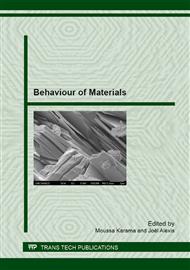p.127
p.135
p.143
p.157
p.165
p.171
p.179
p.189
p.197
Nanoscale Numerical and Reliability Method for Nano-Cantilever
Abstract:
Most of nanostructures are desired in nanodevices in order to perform their characteristics. Tiny, strong and stable nanomaterials are needed to get functional nanosensor, nanoactuator and nanodevices. For those reasons, we introduce the single walled carbon nanotube (SWCNTS) as a high flexural and cylindrical nanocantilever to reduce the electrical and mechanical lost energy. Therefore, a bundle of SWCNTs in cylindrical geometry with a diameter of about 5 nm and 60 nm as long was designed in clamped-free cantilever feature. Due to the exceptional mechanical and geometrical characteristic of SWCNT, the first resonance frequency was calculated by analytical method to be of 150MHz. Further research, the SWCNT nanocantilever could be covered with a thin piezoelectric layer such as PZT, ZNO, AlN, PVDF...to realize nanactuators, nanosensors and nanodevices. The proposed methodology directly supports quality engineering aspects enabling to specify the manufacturing to achieve desired product reliability. Within this context, the robust design obtained is optimal over the range of variable conditions because it considers uncertainties during the optimization process. The large number of exact evaluations of problem, combined with the typically high dimensions of Finite Element models, makes reliability-based optimization procedures very costly, sometimes unfeasible. Those difficulties motivate the study reported in this paper, in which a strategy is proposed consisting in the use of reliability-based optimization strategy combined with measurement and sensitivity technique specially adapted to the structures of industrial interested. Keywords: single walled carbon nanotubes, nanocantilever vibration, clamped-clamped, clamped-free. Reliability, Finite Element Method.
Info:
Periodical:
Pages:
189-195
Citation:
Online since:
April 2013
Authors:
Price:
Сopyright:
© 2013 Trans Tech Publications Ltd. All Rights Reserved
Share:
Citation:


